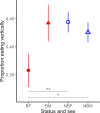Workload distribution in wild Damaraland mole-rat groups
- PMID: 40109115
- PMCID: PMC11923611
- DOI: 10.1098/rstb.2023.0276
Workload distribution in wild Damaraland mole-rat groups
Abstract
The social organization of Damaraland and naked mole-rats is often suggested to resemble the societies of eusocial insects more closely than that of any other vertebrate. Eusocial insects feature queens that hardly contribute to the workforce, and specialized worker castes. However, in Damaraland and naked mole-rats, which live in family groups with a single breeding pair and multiple non-breeding helpers, the work division is still unclear. Previous studies, largely confined to laboratory settings, could not quantify their primary cooperative behaviour, which is digging extensive foraging tunnels. Here, we studied the distribution of workload in 11 wild Damaraland mole-rat groups, using body acceleration loggers to evaluate behavioural time budgets of 86 individuals. We found behavioural differences between breeders and non-breeders that emerged with increases in group size, such that in large groups, breeders spent less time digging, more time resting, and were overall less active than non-breeders. We did not find any indication of a caste system among non-breeders, though the amount of time individuals spent digging varied with age and sex. Overall, the lower contribution by breeders to the group's workload is a pattern rarely observed in other cooperative vertebrates; nevertheless, the lack of evidence for castes suggests that eusociality may be limited to invertebrates.This article is part of the theme issue 'Division of labour as key driver of social evolution'.
Keywords: Mammals; body acceleration logging; caste system; cooperative breeding; eusociality; mole-rats; vertebrate societies; work division.
Conflict of interest statement
We declare we have no competing interests.
Figures




References
-
- Jarvis JUM, Bennett NC. 1993. Eusociality has evolved independently in two genera of bathyergid mole-rats — but occurs in no other subterranean mammal. Behav. Ecol. Sociobiol. 33, 253–260. (10.1007/bf02027122) - DOI
MeSH terms
Grants and funding
LinkOut - more resources
Full Text Sources

